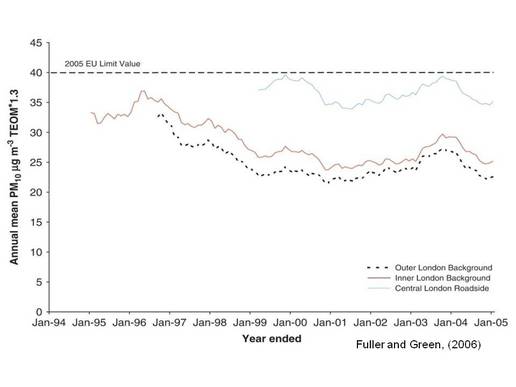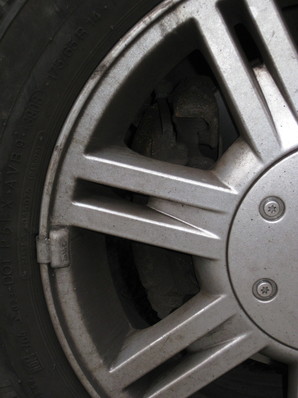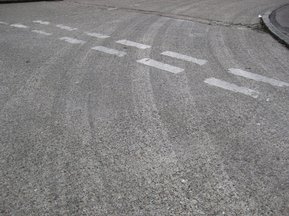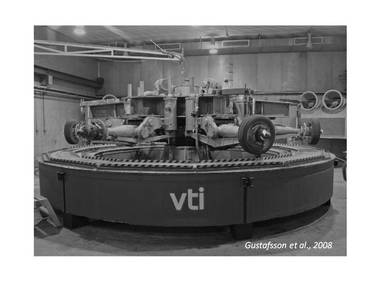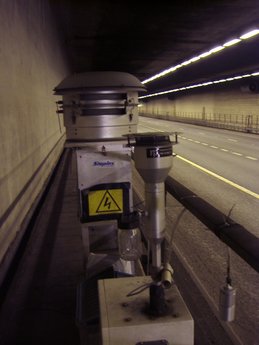Non-exhaust emission sources
In addition to the by-products of fuel combustion, there are other ways that vehicles can contribute to particulate air pollution. As part of her PhD studies, completed in 2009, Samantha Lawrence from the University of Hertfordshire investigated the sources and measurement of non-exhaust vehicle pollution.
Atmospheric particle pollution
Atmospheric pollution is a global problem and the links between poor air quality and adverse health effects are well documented (e.g. Dockery and Pope, 1994; Miguel et al., 1999). Air pollution is thought to be directly responsible for a reduction in the life expectancy of a person living in the UK by an average of 7-8 months. This corresponds to additional health costs of up to £20 billion each year (DEFRA, 2007). As part of a number of measures to improve air quality, the European Union (EU) issued the ‘First Air Quality Daughter Directive’ in 1999 (1999/30/EC) (http://europa.eu/legislation_summaries/index_en.htm) followed by a number of amendments, with the latest directive (2008/50/EC) published in May 2008.
Road transport is a major source of air pollution, and particulate matter (PM10) emissions from vehicles account for 20% of primary emissions nationally and ~70% of the total PM10 emissions in London (PM10 is particulate matter with an aerodynamic diameter of up to 10 µm) (Fuller and Green, 2006; Mattai and Hutchinson, 2006). Although particulate exhaust emissions from vehicles are regulated, non-exhaust vehicle emissions are not at present subject to regulatory scrutiny. This article describes the sources and measurement of non-exhaust particulate emissions.
Road transport emissions
Recent studies have shown an increase in the number of UK registered vehicles; almost 34 million vehicles were registered in the UK during 2007, an increase of 2% compared to the previous year (DFT, 2008). As vehicle numbers increase, road transport is expected to continue to be the largest emission source of particles into the atmosphere for the foreseeable future. Legislation and policies have focused on reducing the impact of vehicle exhaust emissions and, as a result, annual concentrations have actually decreased. Figure 1 shows the average annual concentrations of PM10 in London at three different types of monitoring station: outer London background; inner London background; and a central London roadside (Fuller and Green, 2006). There is a clear difference between the background and the central London roadside site, highlighting the impact of traffic emissions. A reduction in PM10 concentrations from 1996 – 2001 can be seen. After this time, concentrations appear to level off with a slight increase during 2003 due to a number of particle episodes caused by secondary PM10 from distant sources and photochemistry.
Atmospheric particle pollution
Atmospheric pollution is a global problem and the links between poor air quality and adverse health effects are well documented (e.g. Dockery and Pope, 1994; Miguel et al., 1999). Air pollution is thought to be directly responsible for a reduction in the life expectancy of a person living in the UK by an average of 7-8 months. This corresponds to additional health costs of up to £20 billion each year (DEFRA, 2007). As part of a number of measures to improve air quality, the European Union (EU) issued the ‘First Air Quality Daughter Directive’ in 1999 (1999/30/EC) (http://europa.eu/legislation_summaries/index_en.htm) followed by a number of amendments, with the latest directive (2008/50/EC) published in May 2008.
Road transport is a major source of air pollution, and particulate matter (PM10) emissions from vehicles account for 20% of primary emissions nationally and ~70% of the total PM10 emissions in London (PM10 is particulate matter with an aerodynamic diameter of up to 10 µm) (Fuller and Green, 2006; Mattai and Hutchinson, 2006). Although particulate exhaust emissions from vehicles are regulated, non-exhaust vehicle emissions are not at present subject to regulatory scrutiny. This article describes the sources and measurement of non-exhaust particulate emissions.
Road transport emissions
Recent studies have shown an increase in the number of UK registered vehicles; almost 34 million vehicles were registered in the UK during 2007, an increase of 2% compared to the previous year (DFT, 2008). As vehicle numbers increase, road transport is expected to continue to be the largest emission source of particles into the atmosphere for the foreseeable future. Legislation and policies have focused on reducing the impact of vehicle exhaust emissions and, as a result, annual concentrations have actually decreased. Figure 1 shows the average annual concentrations of PM10 in London at three different types of monitoring station: outer London background; inner London background; and a central London roadside (Fuller and Green, 2006). There is a clear difference between the background and the central London roadside site, highlighting the impact of traffic emissions. A reduction in PM10 concentrations from 1996 – 2001 can be seen. After this time, concentrations appear to level off with a slight increase during 2003 due to a number of particle episodes caused by secondary PM10 from distant sources and photochemistry.
|
So why, after the introduction of strategies to decrease PM10 emissions including the introduction of exhaust emission limits and the installation of particle traps in new diesel vehicles, have PM10 concentrations remained relatively stable? One suggestion is that car manufacturers have adjusted the engine’s emission map. This adjustment may result in lower emissions when vehicles are driven under the conditions of the standard test cycles (Harrison et al., 2008). However, when driven in normal circumstances, vehicle particle emissions could be much higher resulting in an underestimation of exhaust emissions. Another possibility is that the legislation only focuses on reducing emissions from the exhaust pipe of the vehicle and ignores other vehicle-related emissions. As traffic volumes increase, the problems associated with non-exhaust emissions will become more apparent.
|
Why are non-exhaust emissions important?
Studies have shown that non-exhaust emissions can equal or surpass those from the exhaust pipe. In Berlin, vehicular emissions increased PM10 concentrations by up to 40% (Lenschow et al., 2001). Over half of this increment was assigned to non-exhaust emissions. In some parts of the USA, 90% of PM10 levels come from non-exhaust emissions (Abu-Allaban et al., 2003). Jones et al., (2008) found weekday non-exhaust emissions at a roadside site in Birmingham, UK contributed ca. 20% of PM10 emissions. Even with mounting evidence regarding their significance, there is still insufficient legislation to reduce non-exhaust particulates – partly due to the limited amount of information about their origins and concentrations.
What are non-exhaust emissions?
Non-exhaust vehicle emissions are released through processes unrelated to fuel combustion and not emitted from the exhaust pipe of the vehicle. Non-exhaust emissions are generated:
Studies have shown that non-exhaust emissions can equal or surpass those from the exhaust pipe. In Berlin, vehicular emissions increased PM10 concentrations by up to 40% (Lenschow et al., 2001). Over half of this increment was assigned to non-exhaust emissions. In some parts of the USA, 90% of PM10 levels come from non-exhaust emissions (Abu-Allaban et al., 2003). Jones et al., (2008) found weekday non-exhaust emissions at a roadside site in Birmingham, UK contributed ca. 20% of PM10 emissions. Even with mounting evidence regarding their significance, there is still insufficient legislation to reduce non-exhaust particulates – partly due to the limited amount of information about their origins and concentrations.
What are non-exhaust emissions?
Non-exhaust vehicle emissions are released through processes unrelated to fuel combustion and not emitted from the exhaust pipe of the vehicle. Non-exhaust emissions are generated:
- during the mechanical processes associated with driving such as brake, clutch or tyre wear;
- through road surface wear or the resuspension of road dust as the vehicle travels over the road surface; and
- from the corrosion of vehicle components.
|
Brake wear. Brakes reduce vehicle speeds by using friction to convert kinetic energy to thermal energy, producing debris and particles through the abrasion of the brake linings, rotors, pad or discs. During a lifetime, 80% of the brake’s friction material will wear away (Garg et al., 2000). Figure 2 clearly shows brake dust collected on a vehicle wheel; this is either released into the atmosphere or deposited onto the road surface ready to be resuspended by other vehicles. A number of factors can contribute to differences in wear rates, including the brake pad’s chemical composition and its microstructure, rate of wheel rotation, pressure, rubbing speed, the metallic counter face, contact surface temperature and the resistance of the weight being stopped (Ingo et al., 2004). Brake materials are a mixture of modifiers, binders, fillers, lubricants and carbon material. Brake dust contains high concentrations of Al, Ba, Ca, Cu, Fe, K, Mg, Sb, Ti and Zn (Hildemann et al., 1991; Kennedy and Gadd, 2003). Researchers have found that during braking, an average of 35% of the brake wear material is lost and emitted as airborne particulate matter (Garg et al., 2000). Researchers have shown that brake wear may account for 14% of the total PM10 mass (Stocker and Carruthers, 2007).
|
Tyre wear. During rotation, tyres abrade against the road surface and the abrasion of the tyre tread generates particles of dust and debris. Tyre wear is a growing problem due to the ever increasing number of tyres in use. In Britain, over 47 million tyres were discarded during 2005 – about 100,000 worn tyres a day (Used Tyre Group, 2007). Figure 3 shows tyre wear particles deposited on a road surface. As vehicle numbers increase, the number of tyres in use could be as much as 200 million by 2021 (Environment Agency, 1999). Tyres are a complex mixture of very different materials, including steel cord, several types of rubber, carbon black and other organic materials and inorganic compounds. During braking, the majority of the weight of a front-wheel drive vehicle is shifted onto the front wheels of the vehicle. Also, the engine is normally positioned at the front of the vehicle, so additional weight is loaded here. This explains why the tyre wear from the front wheels of a front-wheel drive car accounts for 69-85% of the total tyre material lost per vehicle per km (Luhana et al., 2004). Tyre wear particles contain high concentrations of Al, Ca, Fe, Na and Zn and organic compounds such as styrene butadiene rubber, benzothiazole and polycyclic aromatic hydrocarbons (Hildemann et al., 1991; Rogge et al., 1993; Kennedy and Gadd, 2003). It is calculated that tyres contribute 11% of the total PM10 mass (Stocker and Carruthers, 2007).
|
Road surface wear. Road surface wear particles are produced as a result of the shear forces caused by the relative movement of the surfaces during the interaction between the road surface and a vehicle’s tyre. Studded tyres and traction material used in Nordic countries, northern parts of the USA, Japan, and Canada increase road surface wear. Within Europe, concrete and asphalt based road surface materials are commonly used. Concrete surfaces are comprised of sand, cement and small rocks/stones, where as asphalt surfaces consist mainly of bitumen. Concentration of constituents can vary widely between different countries, although general concentrations of stone and bituminous binders are 90-95% and 5-10% respectively (Luhana et al., 2004). Road surface wear particles contain concentrations of Al, Ca, Cr, Fe, K, Ni, Si, V and Zn, which are all present in road surface materials (Kennedy and Gadd, 2003). Road surface wear can contribute as much as 10% of the PM10 mass (Stocker and Carruthers, 2007).
|
Resuspension of road dust. Road dust undergoes a cycle of suspension in the atmosphere and deposition on the ground as a result of turbulence from passing vehicles and the effects of the wind. Resuspended road dust is a complex mixture of particles which originate from natural and anthropogenic sources, and the composition of road dust correlates strongly with local particle emissions. Resuspension of road dust is thought to be the largest contributor to non-exhaust particle emissions. However, there are several problems with sampling and analysing road dust emissions and these have led to uncertainties in calculations of the contribution of resuspended road dust to PM10 concentrations: estimates range from 10-90% (Abu-Allaban et al., 2003; Stocker and Carruthers, 2007). Emission factors also vary considerably; emission factors for resuspension vary from 40 mg/vkm (NAEI, 2008) for the UK to 10,000 mg/vkm, calculated for a mixed fleet using a dispersion model in the USA, where road surface are very different compared to the UK (Venkatram et al. (1999). Road transport emission factors estimate the relationship between the amount of pollution produced and the number of vehicle miles travelled (NAEI, 2008). Emission factors are used by atmospheric dispersion modellers and others to determine the amount of air pollutants being emitted in certain areas, this helps to implement air quality strategies. The UK resuspension emission factor is relatively crude because it does not account for variations in vehicle speed or weight and road or weather conditions. Further research on non-exhaust vehicle emissions in the UK is urgently needed.
Measuring non-exhaust emissions
Quantification of non-exhaust emissions is a difficult task due to the number of uncertainties associated with these pollutants (Lawrence et al., 2009). Concentrations of non-exhaust emissions can vary considerably depending on their origins, which means emission factors can be quite site specific. Currently there are two different approaches for the calculation of non-exhaust emission factors for atmospheric dispersion models: direct measurements (laboratory and dynamometer tests) and receptor modelling (source apportionment studies) (Lawrence et al., 2009).
Measuring non-exhaust emissions
Quantification of non-exhaust emissions is a difficult task due to the number of uncertainties associated with these pollutants (Lawrence et al., 2009). Concentrations of non-exhaust emissions can vary considerably depending on their origins, which means emission factors can be quite site specific. Currently there are two different approaches for the calculation of non-exhaust emission factors for atmospheric dispersion models: direct measurements (laboratory and dynamometer tests) and receptor modelling (source apportionment studies) (Lawrence et al., 2009).
|
Direct measurements. Dynamometer and laboratory tests are direct methods for measuring vehicle emissions and have been used by several researchers including Dannis, (1974); Cadle & Williams (1978), Garg et al. (2000), and Gustafsson et al., (2008). Figure 4 shows the road simulator used by the Swedish National Road and Transport Research Institute, Linköping to generate particles from tyre and road surface wear (Gustafsson et al., 2008). Emission factors are determined by operating a vehicle for a selected period of time over simulated driving conditions, usually on a dynamometer or on an engine bed. Although these tests provide a valuable insight into the processes associated with non-exhaust emissions, they are expensive and time-consuming and do not accurately represent actual driving conditions, where weather conditions, road surface and other factors influence emissions.
|
Receptor modelling. Receptor modelling (also known as source apportionment studies) is another method for studying emission factors. Receptor modelling techniques have been developed to identify and apportion the various source contributions to particulate matter concentrations in real world situations. This technique is based on the theory that a given source can be distinguished by the particles it produces, their size, density, and chemical characteristics (Hopke et al., 1980; see also Hopke, 1989 and 1991).
Researchers in the UK have used receptor modelling techniques to reduce the uncertainties related to non-exhaust emissions. In a Defra-funded project, the Transport Research Laboratory undertook a literature review of non-exhaust emissions and developed the ADMS-Urban dispersion model to improve the prediction of non-exhaust emissions (Stocker and Carruthers, 2007). Further information may be found on Defra’s web site (Science and Research Projects: Road Vehicle Non-exhaust Particulate Matter: Report on Emission Modelling: Project No. AQ05511).
Researchers in the UK have used receptor modelling techniques to reduce the uncertainties related to non-exhaust emissions. In a Defra-funded project, the Transport Research Laboratory undertook a literature review of non-exhaust emissions and developed the ADMS-Urban dispersion model to improve the prediction of non-exhaust emissions (Stocker and Carruthers, 2007). Further information may be found on Defra’s web site (Science and Research Projects: Road Vehicle Non-exhaust Particulate Matter: Report on Emission Modelling: Project No. AQ05511).
|
Road tunnel sampling. Sampling in road tunnels together with statistical techniques such as principal component analysis (PCA) and multi-linear regression analysis (MLRA) have helped to identify non-exhaust emission sources and allowed the calculation of non-exhaust emission factors (Luhana et al., 2004).
In research funded by the National Environmental Research Council (NERC) and the BOC foundation and undertaken as part of my PhD studies, we refined tunnel sampling methodologies. Tunnel sampling was undertaken inside the Hatfield Tunnel, Hertfordshire, which is part of the A1(M) motorway between junctions 3 and 4, 0.8 km west of Hatfield town centre. Figure 5 shows the air sampling equipment used (Lawrence et al., 2009). Non-exhaust emissions were studied from traffic that used the tunnel in peak and off-peak times. Analytical data (metal ion and organic contaminants) and source apportionment techniques were used to calculate source specific emission factors (Lawrence et al., 2009). Although the results of this study (to be published in 2009) are related to a tunnel environment, they also provide an insight into the impact of non-exhaust emissions on road side particle concentrations compared with the results from laboratory tests. |
Public awareness of non-exhaust vehicle pollution
As well as trying to reduce the uncertainties associated with analysing non-exhaust emissions, we are also attempting to raise public awareness of this source of traffic pollution. There is a common misconception that vehicles only harm the environment through exhaust emissions. If we wish to reduce non-exhaust emissions, then a greater public understanding is needed. Through the creation of a web site (www.ies-uk.org.uk/non-exhaust which explains how the general public can help to improve air quality in general, and moderate vehicle pollution in particular, we hope that awareness of non-exhaust sources of vehicle pollution will increase.
Summary
As engine vehicles evolve and alternative cleaner (non-hydrocarbon) fuels are developed, the impact of non-vehicle emissions will become more significant. Cars containing large batteries and/or heavy duty storage tanks are likely to be heavier and consequently non-exhaust emissions will increase. Providing policy makers with improved scientific data on non-exhaust particulate emissions will help to meet EU objectives and standards, and will benefit both the quality of our air and public health.
Acknowledgements
I would like to thank the National Environmental Research Council (NERC) and BOC Foundation who provided the financial assistance, which made my PhD possible. Support and funding obtained from the Institute of Environmental Sciences’ John Rose Award is also appreciated and has enabled the development of the non-exhaust pollution website (www.ies-uk.org.uk/non-exhaust). The guidance and advice obtained from my principal supervisor Professor Ranjeet Sokhi regarding this article is also acknowledged.
References
Abu-Allaban, M.; Gillies J. A.; Gertler, A. W.; Clayton, R.; Proffitt, D. (2003), ‘Tailpipe, resuspended road dust, and brake-wear emission factors from on-road vehicles’, Atmospheric Environment, 37, 5283-5293.
Cadle, S. H.; Williams, R. L. (1978), ‘Gas and particle emissions from automobile tires in laboratory and field studies’, Rubber Chemistry and Technology, 52, 146-158.
Dannis, M. L. (1974), ‘Rubber dust from the normal wear of tires’, Rubber Chemistry and Technology, 47, 1011-1037.
Defra (2007), Department for Environment, Food and Rural Affairs, The Air Quality Strategy for England, Scotland, Wales and Northern Ireland, Volume 1. ISBN 978-0-10-171692-5
DfT (2008), Department for Transport: Transport Statistics Bulletin, Vehicle Licensing Statistics 2007: http://www.dft.gov.uk/pgr/statistics/datatablespublications/vehicles/licensing/vehiclelicensingstatistics2007
Dockery, D. W.; Pope, C. A, III, (1994), ‘Acute respiratory effects of particulate air pollution’, Annual Review of Public Health, 15, 107-32.
Environment Agency (1999), ‘Environment Agency News: Tyres in the Environment: Executive Summary’, The Science of the Total Environment, 234, 243-245.
Fuller, G. W; Green, D. (2006), ‘Evidence for increasing concentrations of primary PM10 in London’ Atmospheric Environment, 40, 6134-6145.
Garg, B. D.; Cadle, S. H.; Mulawa, P. A.; Groblicki, P. J.; Laroo, C.; Parr, G. A. (2000), ‘Brake wear particulate matter emissions’, Environmental Science and Technology, 34, 4463-4469.
Gustafsson, M.; Blomqvist, G.; Gudmundsson, A.; Dahl, A.; Swietlicki, E.; Bohgard, M.; Lindbom, J.; Ljungman, A. (2008), ‘Properties and toxicological effects of particles from the interaction between tyres, road pavement and winter traction material’ Science of The Total Environment, 393, 226-240.
Harrison, R. M.; Jones, A. M.; Lawrence, R. G. (2004), ‘Major component composition of PM10 and PM2.5 from roadside and urban background sites’, Atmospheric Environment, 38, 4531-4538.
Harrison, R. M.; Stedman, J.; Derwent, D. (2008), ‘New directions: Why are PM10 concentrations in Europe not falling?’ Atmospheric Environment, 42, 603-606.
Hildemann, L. M.; Markowski, G. R.; Cass, G. R. (1991), ‘Chemical composition of emissions from urban sources of fine organic aerosol’, Environmental Science and Technology, 25, 744-759.
Hopke, P. K.; Lamb, R. E.; Natusch, D. F. S. (1980), ‘Multi-elemental characterization of urban roadway dust’, Environmental Science and Technology, 14, 164-172.
Hopke, P. K. (1989), ‘Target transformation factor analysis’, Chemometrics and Intelligent Laboratory Systems, 6, 7-19.
Hopke, P. K. (1991), ‘An introduction to receptor modelling’ Chemometrics and Intelligent Laboratory Systems, 10, 21-43.
Ingo, G. M.; D’Uffizi, M.; Falso, G.; Bultrini, G.; Padeletti, G. (2004), ‘Thermal and microchemical investigation of automotive brake pad wear residues’ Thermochimica Acta, 418, 61-68.
Jones, A. M.; Yin, J.; Harrison, R. M. (2008), ‘The weekday-weekend difference and the estimation of the non-vehicle contributions to the urban increment of airborne particulate matter’, Atmospheric Environment, 42, 4467-4479.
Kennedy, P.; Gadd, J. (2003), ‘Preliminary examination of trace elements in tyres, brake pads, and road bitumen in New Zealand’, Prepared for Ministry of Transport, New Zealand, Infrastructure Auckland; 2003.
Lawrence, S.; Sokhi, R. S.; Mao, H.; Ravindra, K.; Bull, I. D. (2009), ‘Quantification of atmospheric particle emissions from non-exhaust sources using tunnel measurements and source apportionment modelling’, Proceedings of Short Papers presented at the 7th International Conference on Air Quality: Science and Application, (Air Quality 2009), Istanbul, Turkey, 24-27th March 2009. ISBN 978-1-905313-64-8.
Lenschow, P.; Abraham, H. J.; Kutzner, K.; Lutz, M.; Preu, J. D.; Reichenbacher, W. (2001), ‘Some ideas about the sources of PM10’, Atmospheric Environment, 35, 23-33.
Luhana, L.; Sokhi, R.; Warner, L.; Mao, H.; Boulter, P.; McCrae, I.; Wright, J.; Osborn, D. (2004), ‘Characterisation of exhaust particulate emissions from road vehicles (particulates)’, FP5 Particulates Project.
Mattai, J., Hutchinson, D (2006), ‘London atmospheric emissions inventory: 2003 Report’, Greater London Authority, London. ISBN-1-85261-801-9
Miguel, A. G.; Cass, G. R.; Glovsky, M. M.; Weiss, J. (1999), ‘Allergens in paved road dust and airborne particles’, Environmental Science and Technology, 33, 4159-4168.
NAEI (2008), National Atmospheric Emission Inventory, ‘Emission factors for PM10 for road transport: Year 2007’.
Rogge, W. F.; Hildemann, L. M.; Mazurek, M. A.; Cass, G. R.; Simoneit, B. R. T. (1993), ‘Sources of fine organic aerosol. 3. Road dust, tire debris, and organometallic brake lining dust: roads as sources and sinks’, Environmental Science and Technology, 27, 1892-1904.
Stocker, J.; Carruthers, D. (2007), ‘Road vehicle non-exhaust particulate matter: Initial air quality model development and application, model uncertainty analysis and further model improvements’, Report PPR224, Transport Research Laboratory (TRL).
Used Tyre Group (2007), www.tyredisposal.co.uk. Accessed 22/08/2007.
Venkatram, A.; Fitz, D.; Bumiller, K.; Du S.; Boeck, M.; Ganguly, C. (1999), ‘Using a dispersion model to estimate emission rates of particulate matter from paved roads’, Atmospheric Chemistry, 33, 1093-1102.
Dr SAMANTHA LAWRENCE
Centre for Atmospheric & Instrumentation Research (CAIR),
University of Hertfordshire, College Lane, Hatfield, Hertfordshire AL10 9AB, UK
Email: [email protected]
http://strc.herts.ac.uk/cair/
BIOGRAPHICAL NOTE: Samantha Lawrence was the winner of The Institution of Environmental Sciences’ John Rose Award in 2008 for her PhD research on the analysis of non-exhaust particles. With the prize money from this award, Samantha set up a web site (www.ies-uk.org.uk/non-exhaust, described in this article, to inform the wider public about non-exhaust emissions from vehicles.
As well as trying to reduce the uncertainties associated with analysing non-exhaust emissions, we are also attempting to raise public awareness of this source of traffic pollution. There is a common misconception that vehicles only harm the environment through exhaust emissions. If we wish to reduce non-exhaust emissions, then a greater public understanding is needed. Through the creation of a web site (www.ies-uk.org.uk/non-exhaust which explains how the general public can help to improve air quality in general, and moderate vehicle pollution in particular, we hope that awareness of non-exhaust sources of vehicle pollution will increase.
Summary
As engine vehicles evolve and alternative cleaner (non-hydrocarbon) fuels are developed, the impact of non-vehicle emissions will become more significant. Cars containing large batteries and/or heavy duty storage tanks are likely to be heavier and consequently non-exhaust emissions will increase. Providing policy makers with improved scientific data on non-exhaust particulate emissions will help to meet EU objectives and standards, and will benefit both the quality of our air and public health.
Acknowledgements
I would like to thank the National Environmental Research Council (NERC) and BOC Foundation who provided the financial assistance, which made my PhD possible. Support and funding obtained from the Institute of Environmental Sciences’ John Rose Award is also appreciated and has enabled the development of the non-exhaust pollution website (www.ies-uk.org.uk/non-exhaust). The guidance and advice obtained from my principal supervisor Professor Ranjeet Sokhi regarding this article is also acknowledged.
References
Abu-Allaban, M.; Gillies J. A.; Gertler, A. W.; Clayton, R.; Proffitt, D. (2003), ‘Tailpipe, resuspended road dust, and brake-wear emission factors from on-road vehicles’, Atmospheric Environment, 37, 5283-5293.
Cadle, S. H.; Williams, R. L. (1978), ‘Gas and particle emissions from automobile tires in laboratory and field studies’, Rubber Chemistry and Technology, 52, 146-158.
Dannis, M. L. (1974), ‘Rubber dust from the normal wear of tires’, Rubber Chemistry and Technology, 47, 1011-1037.
Defra (2007), Department for Environment, Food and Rural Affairs, The Air Quality Strategy for England, Scotland, Wales and Northern Ireland, Volume 1. ISBN 978-0-10-171692-5
DfT (2008), Department for Transport: Transport Statistics Bulletin, Vehicle Licensing Statistics 2007: http://www.dft.gov.uk/pgr/statistics/datatablespublications/vehicles/licensing/vehiclelicensingstatistics2007
Dockery, D. W.; Pope, C. A, III, (1994), ‘Acute respiratory effects of particulate air pollution’, Annual Review of Public Health, 15, 107-32.
Environment Agency (1999), ‘Environment Agency News: Tyres in the Environment: Executive Summary’, The Science of the Total Environment, 234, 243-245.
Fuller, G. W; Green, D. (2006), ‘Evidence for increasing concentrations of primary PM10 in London’ Atmospheric Environment, 40, 6134-6145.
Garg, B. D.; Cadle, S. H.; Mulawa, P. A.; Groblicki, P. J.; Laroo, C.; Parr, G. A. (2000), ‘Brake wear particulate matter emissions’, Environmental Science and Technology, 34, 4463-4469.
Gustafsson, M.; Blomqvist, G.; Gudmundsson, A.; Dahl, A.; Swietlicki, E.; Bohgard, M.; Lindbom, J.; Ljungman, A. (2008), ‘Properties and toxicological effects of particles from the interaction between tyres, road pavement and winter traction material’ Science of The Total Environment, 393, 226-240.
Harrison, R. M.; Jones, A. M.; Lawrence, R. G. (2004), ‘Major component composition of PM10 and PM2.5 from roadside and urban background sites’, Atmospheric Environment, 38, 4531-4538.
Harrison, R. M.; Stedman, J.; Derwent, D. (2008), ‘New directions: Why are PM10 concentrations in Europe not falling?’ Atmospheric Environment, 42, 603-606.
Hildemann, L. M.; Markowski, G. R.; Cass, G. R. (1991), ‘Chemical composition of emissions from urban sources of fine organic aerosol’, Environmental Science and Technology, 25, 744-759.
Hopke, P. K.; Lamb, R. E.; Natusch, D. F. S. (1980), ‘Multi-elemental characterization of urban roadway dust’, Environmental Science and Technology, 14, 164-172.
Hopke, P. K. (1989), ‘Target transformation factor analysis’, Chemometrics and Intelligent Laboratory Systems, 6, 7-19.
Hopke, P. K. (1991), ‘An introduction to receptor modelling’ Chemometrics and Intelligent Laboratory Systems, 10, 21-43.
Ingo, G. M.; D’Uffizi, M.; Falso, G.; Bultrini, G.; Padeletti, G. (2004), ‘Thermal and microchemical investigation of automotive brake pad wear residues’ Thermochimica Acta, 418, 61-68.
Jones, A. M.; Yin, J.; Harrison, R. M. (2008), ‘The weekday-weekend difference and the estimation of the non-vehicle contributions to the urban increment of airborne particulate matter’, Atmospheric Environment, 42, 4467-4479.
Kennedy, P.; Gadd, J. (2003), ‘Preliminary examination of trace elements in tyres, brake pads, and road bitumen in New Zealand’, Prepared for Ministry of Transport, New Zealand, Infrastructure Auckland; 2003.
Lawrence, S.; Sokhi, R. S.; Mao, H.; Ravindra, K.; Bull, I. D. (2009), ‘Quantification of atmospheric particle emissions from non-exhaust sources using tunnel measurements and source apportionment modelling’, Proceedings of Short Papers presented at the 7th International Conference on Air Quality: Science and Application, (Air Quality 2009), Istanbul, Turkey, 24-27th March 2009. ISBN 978-1-905313-64-8.
Lenschow, P.; Abraham, H. J.; Kutzner, K.; Lutz, M.; Preu, J. D.; Reichenbacher, W. (2001), ‘Some ideas about the sources of PM10’, Atmospheric Environment, 35, 23-33.
Luhana, L.; Sokhi, R.; Warner, L.; Mao, H.; Boulter, P.; McCrae, I.; Wright, J.; Osborn, D. (2004), ‘Characterisation of exhaust particulate emissions from road vehicles (particulates)’, FP5 Particulates Project.
Mattai, J., Hutchinson, D (2006), ‘London atmospheric emissions inventory: 2003 Report’, Greater London Authority, London. ISBN-1-85261-801-9
Miguel, A. G.; Cass, G. R.; Glovsky, M. M.; Weiss, J. (1999), ‘Allergens in paved road dust and airborne particles’, Environmental Science and Technology, 33, 4159-4168.
NAEI (2008), National Atmospheric Emission Inventory, ‘Emission factors for PM10 for road transport: Year 2007’.
Rogge, W. F.; Hildemann, L. M.; Mazurek, M. A.; Cass, G. R.; Simoneit, B. R. T. (1993), ‘Sources of fine organic aerosol. 3. Road dust, tire debris, and organometallic brake lining dust: roads as sources and sinks’, Environmental Science and Technology, 27, 1892-1904.
Stocker, J.; Carruthers, D. (2007), ‘Road vehicle non-exhaust particulate matter: Initial air quality model development and application, model uncertainty analysis and further model improvements’, Report PPR224, Transport Research Laboratory (TRL).
Used Tyre Group (2007), www.tyredisposal.co.uk. Accessed 22/08/2007.
Venkatram, A.; Fitz, D.; Bumiller, K.; Du S.; Boeck, M.; Ganguly, C. (1999), ‘Using a dispersion model to estimate emission rates of particulate matter from paved roads’, Atmospheric Chemistry, 33, 1093-1102.
Dr SAMANTHA LAWRENCE
Centre for Atmospheric & Instrumentation Research (CAIR),
University of Hertfordshire, College Lane, Hatfield, Hertfordshire AL10 9AB, UK
Email: [email protected]
http://strc.herts.ac.uk/cair/
BIOGRAPHICAL NOTE: Samantha Lawrence was the winner of The Institution of Environmental Sciences’ John Rose Award in 2008 for her PhD research on the analysis of non-exhaust particles. With the prize money from this award, Samantha set up a web site (www.ies-uk.org.uk/non-exhaust, described in this article, to inform the wider public about non-exhaust emissions from vehicles.

